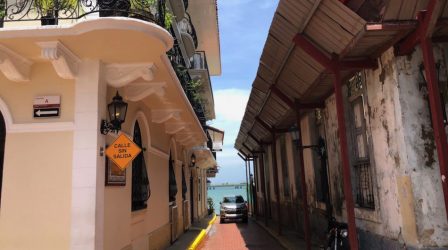
(Caribbean Journal) There’s a reason they put a canal here.
Panama is the thinnest sliver of the Americas, the most logical place to put the world’s most important shipping route, the isthmic keyhole from the Caribbean Sea to the Pacific.
And as the locks of the Panama Canal open and close throughout the day the waters that flow between the Caribbean Sea, Lake Gatun and the Pacific are a daily reminder; this is two worlds in one.
Indeed, Panama is very much a place of dual identity: at once Caribbean and Pacific; a modern financial hub that’s also home to some of the most pristine coastal cays in the hemisphere.
And Panama City is the perfect example of this dichotomous personality: at one corner, it’s a forest of towering, newly-built skyscrapers; but at the city’s edge, there’s a centuries-old jewel.

This is the Casco Viejo, the colorful colonial town almost four centuries old that is the soul of Panama City, the place where Panama largely began, and a destination that, when unseen, makes any visit to Panama incomplete.
Thanks to a recent, large-scale beautification effort, the cobblestone streets and pastel walls shine brilliantly, and a new push has turned this UNESCO World Heritage site into a vibrant cultural pole.

People are once again drawn to this old town basking in the shadow of modernity, as locals move back in and travelers slowly begin to rediscover it.
The narrow streets with two and three-story buildings on either side, all of them straddling the water, some with flower-filled balconies, instantly remind of Jacmel and Pointe-a-Pitre, Santo Domingo and San Juan.
If you’ve been to Spanish colonial towns on either side of the Americas, you’ll somehow feel this a hint more Caribbean.

The bar at La Casa del Habano.
And it’s a feeling that only grows when you walk by a stone-walled La Casa del Habano and a busy rum bar.
The more you walk these streets the more the town reveals itself, every corner offering a beautiful ruin or a brand-new bar, creating energy in the way only reawakened old towns can.

The rooftop of the American Trade Hotel.
There’s Lesseps, the authentic French bistro named for Ferdinand de Lesseps, the man behind the Suez Canal whose dreams of a canal in Panama were dashed by the scourge of tiny flying pests — but who might have been comforted by a hamburger filled with foie gras on a bun toasted with his name.

Down the way there’s Casa Testa, an old building with a friendly eatery with wraps and vegetarian-friendly food; a few steps down a hidden tiki bar in the courtyard of Mahalo.

The secret tiki bar at Mahalo.
At the edge of Plaza Tomas Herrera is Casa Casco, the multi-tiered edifice that is the old quarter’s entertainment hub, with three restaurants, a disco and the most impressive rooftop in town.

The Pedro Mandinga Rum Bar.
And if you had any doubts about this town’s Caribbean chops yes, there’s even a rum bar, Pedro Mandinga, named for a craft rum brand that is the latest addition to what is a robust rum industry in Panama, a place where even the current president’s family owns a rum company, Ron Abuelo.
There’s just no shortage of charm, culture and terrific cuisine here, amid the churches and the walls of Panama hats.

And there are even great places to stay, from hostels to the flagship American Trade Hotel, the spectacular, restored 1917 building with a rooftop pool and a pulsing jazz club.
Because on these sunny streets, set away from the big hotels and the casinos and the condo boom, you don’t completely go back in time — but you certainly take a break from it.